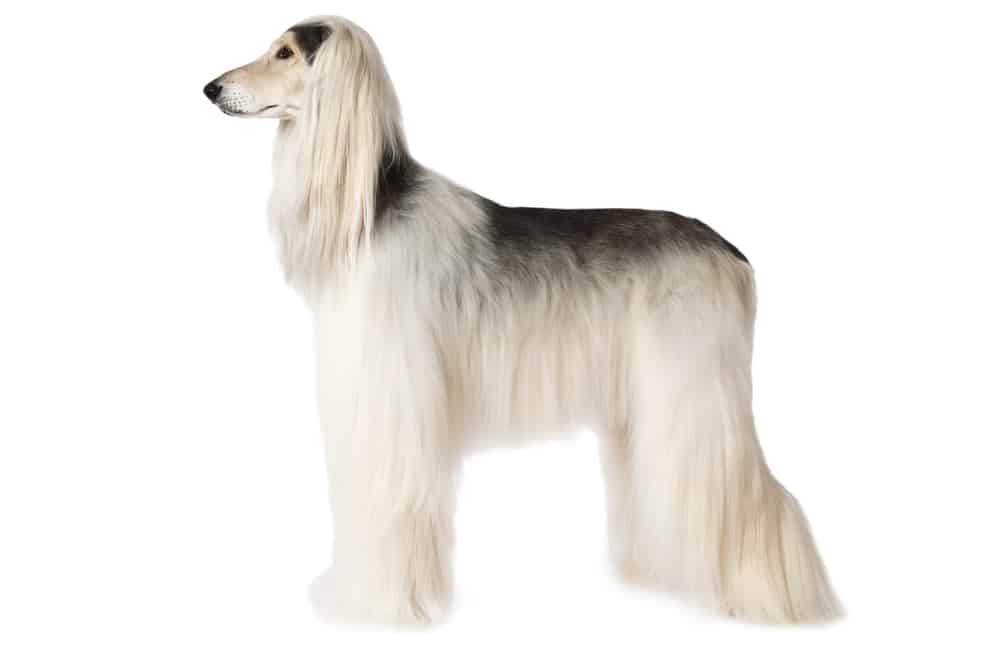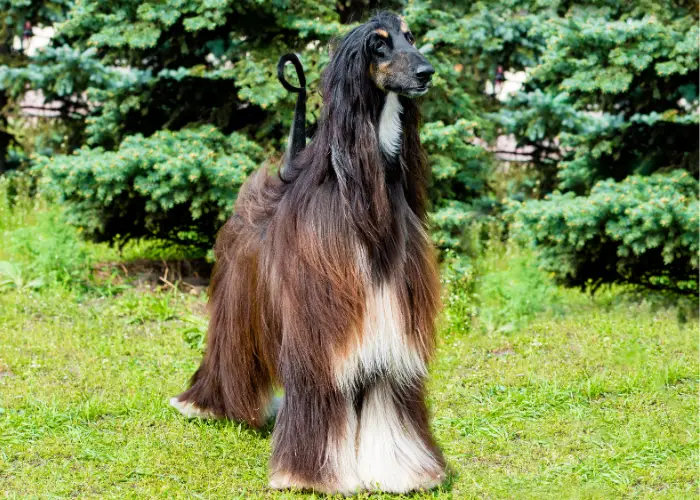Afghanistan dog breeds provide a fascinating look into the country’s rich culture and history.
These distinctive breeds have played various roles throughout the ages, from hunting partners to symbols of wealth and status.
This article will delve into the captivating world of the Afghan Hound, Kuchi, and Khalag Tazi. So, prepare to be amazed by these remarkable dogs’ incredible stories.
1. Afghan Hound: A Majestic Beauty

The Afghan Hound is one of the most iconic Afghan dog breeds, featuring a unique appearance and a rich history.
These graceful canines were once utilized as hunting partners and status symbols due to their slender bodies, long silky hair, and distinct curved tails.
Afghan Hounds possess a lengthy and storied past, with some historians theorizing that they may have been the companions of royalty.
Their sharp intellect, agility, and powerful hunting instincts made them ideal partners for navigating the rugged terrain of Afghanistan’s mountainous regions.
Their beauty and loyalty have won the hearts of dog enthusiasts worldwide, making them a popular breed even today.
History
The Afghan Hound, also known as the Tazi Spay or Ogar Afgan, boasts an ancient lineage that dates back thousands of years.
It is believed that these dogs originated in the regions of Central Asia and the Middle East before migrating to Afghanistan.
Afghan Hounds were utilized by the nomadic tribes of Afghanistan for various purposes, such as hunting and herding, due to their exceptional agility, speed, and endurance.
2. Kuchi: The Robust and Devoted Guardian

Another prominent Afghanistan dog breed is the Kuchi, also known as the Afghan Shepherd or Central Asian Shepherd.
These large, formidable dogs were bred to safeguard livestock and serve as protectors for their human families. With their muscular build and dense coats, they were well-suited to endure the harsh climate of Afghanistan and Central Asia.
Kuchis are renowned for their courage and strength, making them invaluable assets for shepherds and farmers who require protection from predators like wolves and bears.
Their loyalty and protective nature have endeared them to many, and they have become gentle and affectionate companions for their families.
However, their size and temperament might not suit novice dog owners, as they require a strong leader and proper training to thrive.
History:
The Kuchi, also known as the Afghan Shepherd or Central Asian Shepherd, has played an integral role in the lives of the Afghan people for centuries.
This powerful breed was developed to protect livestock like sheep and goats from predators like wolves and bears. They were also responsible for guarding the homes and property of their owners.
3. Khalag Tazi: The Versatile Hunter

The Khalag Tazi, also known as the Mountain Tazi or Khalag Hound, is a lesser-known Afghanistan dog breed that shares many similarities with the Afghan Hound.
These dogs have a unique appearance, featuring a slender body, long legs, and a slightly shorter coat than the Afghan Hound.
The Khalag Tazi is known for its versatility in various hunting and herding activities, making it a valuable companion for the people of Afghanistan.
Khalag Tazis are known for their intelligence, agility, and loyalty, which make them excellent hunters and herders.
Thanks to their solid and agile bodies, they are exceptionally skilled at navigating the rough terrain of Afghanistan’s mountainous regions. Their instincts and adaptability have made them popular among the rural communities of Afghanistan.
History
The Cultural Significance of Afghan Dog Breeds
Afghanistan dog breeds are unique in the country’s culture and history. These breeds were integral to daily life for many Afghans, serving as working dogs and companions.
They also played a role in the country’s economy, as skilled hunting and herding dogs were highly valued and sought after.
Moreover, these breeds have become symbols of Afghanistan’s resilience and strength.
Throughout history, they have adapted to harsh environments, conflicts, and changing societies while maintaining their unique characteristics and abilities.
1. Afghan Hounds
In Afghan culture, Afghan Hounds were valued for their loyalty and ability to navigate the rugged mountainous terrain.
They were used primarily for hunting large game like deer, wild goats, and even snow leopards. Their long, silky coats protected them from the harsh weather conditions in the region.
Afghan Hounds were highly regarded and often owned by tribal chiefs and royalty, who admired them for their elegance and hunting prowess. These dogs were also considered a social status and wealth symbol among the Afghan elite.
2. Kuchi
Kuchi dogs have been essential to the semi-nomadic tribes of Afghanistan, where they have served as guardians and herders.
The bond between these tribes and their Kuchi dogs runs deep, as they rely heavily on these dogs for survival in the challenging conditions of the Afghan countryside.
The Kuchi dog’s loyalty, strength, and protective instincts have earned them a respected place in Afghan culture and history.
3. Khalag Tazi
Khalag Tazis have played a significant role in the daily lives of many Afghans, particularly those living in rural and mountainous regions.
Their versatility in hunting and herding has made them invaluable partners for people who rely on these skills for their livelihood.
The Khalag Tazi’s adaptability, loyalty, and intelligence have earned them a respected place in Afghan culture and history.
Caring for Afghan Dog Breeds
If you want to welcome one of these fascinating Afghanistan dog breeds into your home, it’s essential to understand their unique care requirements.
Each breed has its specific needs, so it’s crucial to be well-informed before committing.
Grooming and Exercise
Afghan Hounds require regular grooming to keep their long, silky hair tangle-free and healthy.
Brushing should be done daily; occasional professional grooming sessions may be necessary to maintain their distinctive appearance.
Kuchis have a thick double coat that needs to be brushed regularly, especially during shedding seasons. This helps to remove loose hair and prevent matting.
Khalag Tazis have shorter coats than Afghan Hounds but still require regular brushing to keep their fur healthy and free from tangles.
They also need ample exercise to stay physically and mentally stimulated, as they are an active breed with a strong work drive.
All three breeds need regular exercise to stay physically and mentally healthy. Afghan Hounds and Salukis, in particular, have high energy levels and will thrive in homes with access to large outdoor spaces where they can run and explore.
Kuchis are also active dogs, but their exercise needs may be slightly lower than the other two breeds.
Training and Socialization
Afghan Hounds, Kuchis, and Khalag Tazis are intelligent breeds but can be independent thinkers who may challenge training.
Early socialization and positive reinforcement-based training methods are essential for success. Consistency and patience will teach these breeds new commands and behaviors.
Remember that these dogs have strong instincts, making them prone to chasing small animals or wandering off. Proper training and secure outdoor spaces will help mitigate these risks and keep your dog safe and happy.
Health Considerations
While Afghan dog breeds are generally healthy, they can still be prone to specific health issues. Regular veterinary check-ups, a balanced diet, and proper care can help ensure your dog enjoys a long and healthy life.
Afghan Hounds may be susceptible to hip dysplasia, heart issues, and eye problems, while Kuchis can experience hip and elbow dysplasia and certain heart conditions.
Khalag Tazis are generally a healthy breed but can be prone to some of the same health issues as Afghan Hounds, such as hip dysplasia and eye problems.
It’s essential to work closely with your veterinarian to monitor your dog’s health and address any concerns as they arise.
Conclusion

Afghanistan dog breeds, such as the Afghan Hound, Kuchi, and Khalag Tazi, offer a fascinating glimpse into the rich history and culture of the country.
Their unique traits and abilities have captivated dog enthusiasts worldwide, and their stories continue to inspire awe and admiration.
If you’re considering adding one of these remarkable breeds to your family, be prepared to invest time and effort into their care, training, and socialization.
With the proper knowledge, dedication, and love, these extraordinary dogs can become cherished companions and enrich your life in countless ways.
Remember that each breed has its own specific needs and requirements, so it’s essential to research and understands the unique characteristics of the Afghan Hound, Kuchi, or Khalag Tazi before welcoming one into your home.
Providing the proper environment, care, and attention ensures a happy and healthy life for your Afghanistan dog breed.
They will reward you with their loyalty, love, and companionship.
REFERENCES;
1. Afghan Hound. (2023, April 20). In Wikipedia. https://en.wikipedia.org/wiki/Afghan_Hound
2. Khalag tazi. (2022, March 26). In Wikipedia. https://no.wikipedia.org/wiki/Khalag_tazi
3. Kuchi dog. (2023, February 12). In Wikipedia. https://en.wikipedia.org/wiki/Kuchi_dog
Check Out More Asian Dogs Below:


